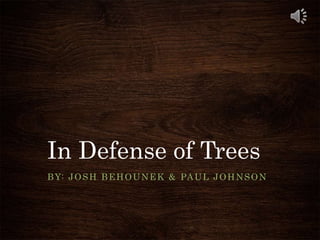In Defense of Trees
- 1. In Defense of Trees BY: JOSH BEHOUNEK & PAUL JOHNSON
- 2. ISA Pledge I pledge as an ISA Certified Arborist to: âĒ Adhere to the Code of Ethics, âĒ Comply with all accepted professional standards, âĒ Deliver safe & competent services with objective & independent professional judgment, âĒ Disclose potential conflict of interest, and âĒ Follow appropriate health & safety procedures to protect clients, employers, employees, and the public.
- 3. The Tree.. Green ash â Fraxinus pennsylvanica 16â dbh Street Tree
- 5. I speak for the treesâĶ
- 6. Negligence âĒ A person is negligent when he or she fails to act as a reasonable prudent person under the circumstances. Duty of Care âĒ A landowner is not only held to the duty of common prudence in maintaining trees on his property, but is also held to an even greater duty of inspection to discover possible defects of a tree in order to prevent it from falling and injuring others. If risk canât be eliminated, it should be mitigated so that acceptable level of risk is achieved.
- 8. Risk Rating
- 9. The benefit$ of trees? âĒ Carbon sequestration âĒ Oxygen âĒ Erosion Control âĒ Aesthetics âĒ Energy Conservation âĒ Storm Water Interception âĒ Pollution Control âĒ Quality of Life
- 10. Annual Benefits âĒ $51 total benefits âĒ 1,438 gallons of stormwater âĒ Conserve 35.2 Kilowatt-hours âĒ 320 pounds of CO2













